Even the best strategies fail when projects miss their deadlines. But effective time management creates a positive ripple effect — preserving budgets, energizing teams, and building client trust, transforming ambitious plans into smooth execution.
Success comes from both what you plan to do and how strategically you manage the time needed to achieve it. Strong project time management creates predictability and provides a structured approach for breaking down work, estimating effort, and scheduling tasks in a logical sequence. By creating a realistic roadmap, teams can focus on execution instead of constantly reacting to unforeseen problems and shifting priorities.
This guide walks through a 7-step process, from setting clear objectives to tracking progress and optimizing for the future. You”ll learn how to build realistic schedules that keep your teams aligned and your projects moving forward.
Try monday work managementKey takeaways
- Project time management organizes teams around shared outcomes by breaking down work into tasks, estimating durations, and creating schedules that prevent costly delays and budget overruns.
- The 7-step mastery process starts with clear SMART objectives and progresses through task breakdown, realistic scheduling, role clarity, progress tracking, and continuous optimization based on lessons learned.
- Centralizing project communication with monday work management provides real-time visibility into timelines, dependencies, and resource allocation, eliminating the scattered information that creates delays.
- Strategic buffer placement at integration points and high-risk activities protects deadlines without encouraging procrastination, while AI-powered insights predict delays before they occur.
- Cross-team coordination requires shared terminology, common standards, and centralized visibility to prevent department-level optimization from creating organization-wide bottlenecks.

What is project time management
Project time management involves planning, scheduling, and controlling how teams allocate time across project activities. This means breaking down work into tasks, estimating durations, and creating schedules that keep projects on track.
Think of it as orchestrating multiple moving parts — people, deadlines, and deliverables — to reach a specific goal by a specific date. Unlike personal time management, project time management coordinates entire teams toward shared outcomes.
The core elements that make project time management work include:
- Work item definition: Breaking large goals into specific, actionable activities
- Duration estimation: Determining how long each task will realistically take
- Dependency mapping: Understanding which tasks must happen before others can start
- Resource scheduling: Assigning the right people to the right work at the right time
These elements come together on one platform with monday work management. Teams can visualize timelines, track progress in real time, and adjust plans when priorities shift, keeping everyone aligned without constant status meetings.
Why project time management matters
When projects run late, the damage extends far beyond missed deadlines. Most organizations routinely experience project failures that prevent them from delivering on their promises, with consequences that are clear: budgets balloon, client relationships strain, and team morale drops as people scramble to catch up.
Project time management prevents these cascading failures. Projects that stay on schedule build trust with stakeholders and create momentum for future initiatives.
The business impact shows up in several key areas:
- Financial performance: On-time delivery protects budgets and enables faster revenue recognition.
- Team sustainability: Realistic schedules prevent burnout and maintain quality standards.
- Competitive advantage: Reliable delivery builds market reputation and client loyalty.
- Strategic alignment: Time management ensures resources focus on highest-priority work.
How often do your projects actually finish on their original timeline? With monday work management, you get transparency that helps teams spot delays early and adjust before small slips become major problems.
Try monday work management7 steps to master time in project management
Mastering project time management means working smarter with a structured approach that keeps teams aligned and deliverables on track. The following 7-step framework transforms chaotic schedules into predictable timelines, giving project managers the tools to estimate accurately, communicate clearly, and adjust confidently when challenges arise.
Step 1: Establish clear objectives
Clear objectives anchor every time management decision. Without specific goals, teams can’t determine what work is necessary or how long it should take, which is critical since a lack of clear goals is a common factor for project failure.
Start with the SMART framework — make objectives Specific, Measurable, Achievable, Relevant, and Time-bound. Instead of “improve customer experience,” try “reduce support ticket response time to under 2 hours by Q3.”
With monday work management, you get help documenting these objectives and connect them directly to project work. This link between strategy and execution keeps everyone focused on outcomes that matter.
Step 2: Break down tasks and deliverables
Large projects become manageable through decomposition. A work breakdown structure (WBS) divides big deliverables into bite-sized tasks that teams can estimate and complete.
Start with your end goal and work backward. If you’re launching a new product feature, break it into design, development, testing, and deployment phases. Then break each phase into specific activities.
The right level of detail makes estimation accurate without creating administrative overhead. Most tasks should take between a few hours and a few days to complete.
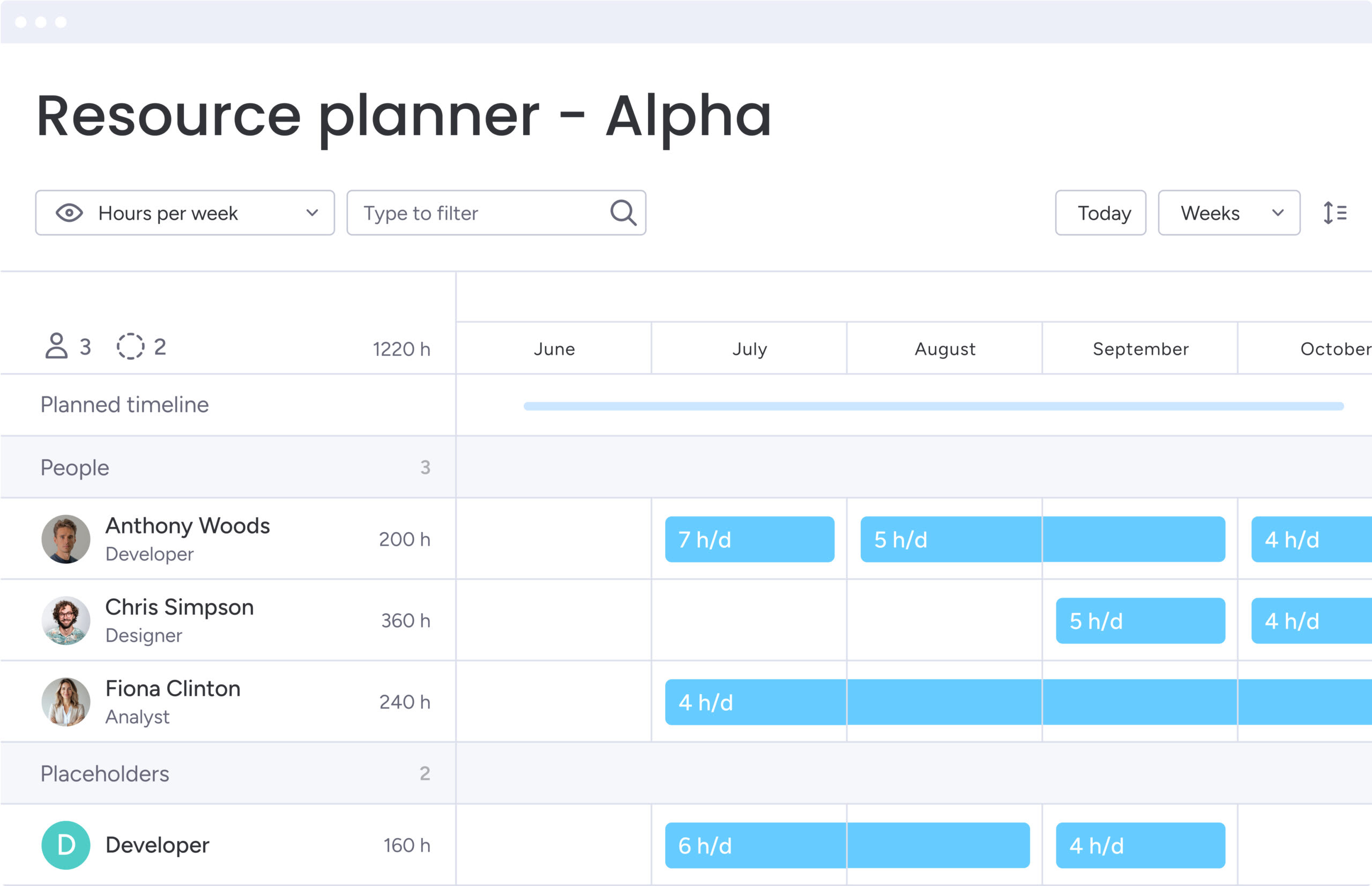
Step 3: Estimate time and resources
Accurate estimates combine data and judgment. Look at similar past work for baseline durations, then adjust for current team capacity and project complexity.
Combine these three powerful estimation techniques for more accurate timelines:
- Analogous estimating: Look at similar completed projects to establish baseline durations
- Expert judgment: Consult the team members who will actually perform the work for realistic timing
- Three-point estimates: Calculate weighted averages using best-case, worst-case, and likely scenarios
Be strategic with buffers. Instead of padding to every task, place time reserves at critical integration points and high-risk areas where delays typically cascade throughout the project.
Step 4: Develop a realistic schedule
Transform your task list into a timeline by mapping dependencies. Some work must finish before other work can start, and these relationships shape your schedule.
The critical path — your longest chain of dependent tasks — determines minimum project duration. Any delay on critical path activities pushes back your end date.
Visual scheduling platforms make dependencies clear. The Gantt view in monday work management shows how tasks connect, helping teams spot opportunities to accelerate delivery through parallel work.
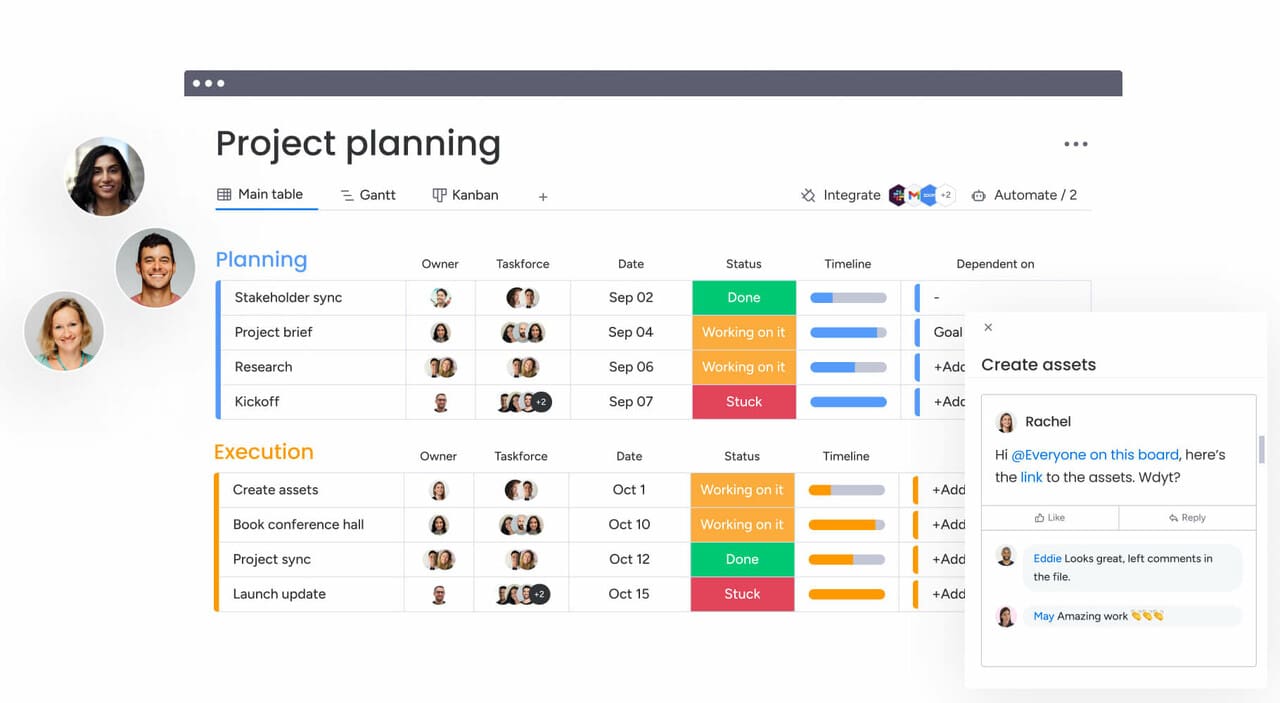
Step 5: Communicate roles and responsibilities
Clear ownership prevents the confusion that causes delays. Every task needs one person accountable for completion, even if multiple people contribute.
Define different levels of involvement using the following RACI model labels:
- Responsible: Who does the work
- Accountable: Who ensures it gets done
- Consulted: Who provides input
- Informed: Who needs updates
With the right software and templates, team members see their upcoming work, understand dependencies, and can communicate directly within task context.
Step 6: Track progress and adjust
Monitoring reveals whether your plan matches reality. Compare actual progress to planned timelines weekly to catch variances while you can still correct them.
Focus on milestone completion rather than daily activities. Trust teams to manage their work while you manage the big picture.
When delays occur, understand why. Was the estimate wrong? Did scope change? Did dependencies shift? This analysis helps you respond appropriately and improve future planning.
Step 7: Review and optimize
Every project teaches lessons about time management. Capture what worked and what didn’t while memories are fresh.
Document insights about estimation accuracy, common delay causes, and effective mitigation strategies. Share these lessons across teams to build organizational capability.
This continuous improvement transforms time management from reactive scrambling to proactive planning that accelerates delivery.
Key strategies for effective time management in projects
Smart project time management combines strategic planning with practical execution tools. The following strategies help teams transform complex projects into manageable processes, ensuring deadlines are met without sacrificing quality or burning out team members.
1. Use a work breakdown structure
A comprehensive WBS provides the foundation for all time management activities. It transforms vague project goals into concrete, manageable work packages.
Consider a website redesign project. Your WBS might include:
- Discovery phase: User research, competitive analysis, requirements gathering
- Design phase: Wireframes, mockups, prototypes, user testing
- Development phase: Frontend coding, backend integration, quality assurance
- Launch phase: Migration planning, deployment, monitoring
Each element breaks down further until you reach tasks one person can complete in a few days.

2. Prioritize with proven techniques
Not all project work deserves equal attention. Prioritization frameworks help teams focus on high-impact activities when time becomes constrained.
The Eisenhower Matrix sorts tasks by urgency and importance:
- Urgent and important: Critical path activities approaching deadlines
- Important but not urgent: Strategic planning and relationship building
- Urgent but not important: Routine requests that can be delegated
- Neither urgent nor important: Activities to eliminate or defer
MoSCoW prioritization works well for feature-based projects, categorizing requirements as Must have, Should have, Could have, or Won’t have this time.

3. Integrate collaboration platforms
Scattered communication creates delays. When updates live in email, chat, and various documents, team members waste time searching for current information.
Centralized platforms eliminate this friction, which is critical since 82% of employees now use work or project management software to track tasks and collaborate. Software like monday work management keeps all project communication in context, with discussions happening directly on relevant tasks, decisions are documented, and everyone works from the same source of truth.
Integration with existing platforms brings project data into familiar workflows, reducing the learning curve and improving adoption.
4. Mitigate time-wasters and delays
Most project delays follow predictable patterns. Recognizing these patterns helps teams prevent problems rather than just react to them.
Here are some common time-wasters and ways to overcome them:
- Scope creep: Establish change control processes that evaluate impact before approval
- Unclear requirements: Document specifications and get stakeholder sign-off upfront
- Communication gaps: Create protocols for updates, escalations, and decisions
- Resource conflicts: Plan capacity across projects to prevent overallocation
Build prevention into your standard processes rather than treating each delay as a unique crisis.
5. Embrace buffer time
Strategic buffers protect deadlines without encouraging procrastination. Place reserves where they provide maximum benefit.
Effective buffer placement includes:
- Integration points: Where multiple work streams converge
- External dependencies: Where you rely on outside vendors or stakeholders
- High-risk activities: Where uncertainty is greatest
- Major milestones: To protect key deliverables
Communicate buffer strategy transparently so teams understand the reasoning and maintain appropriate urgency.
Try monday work management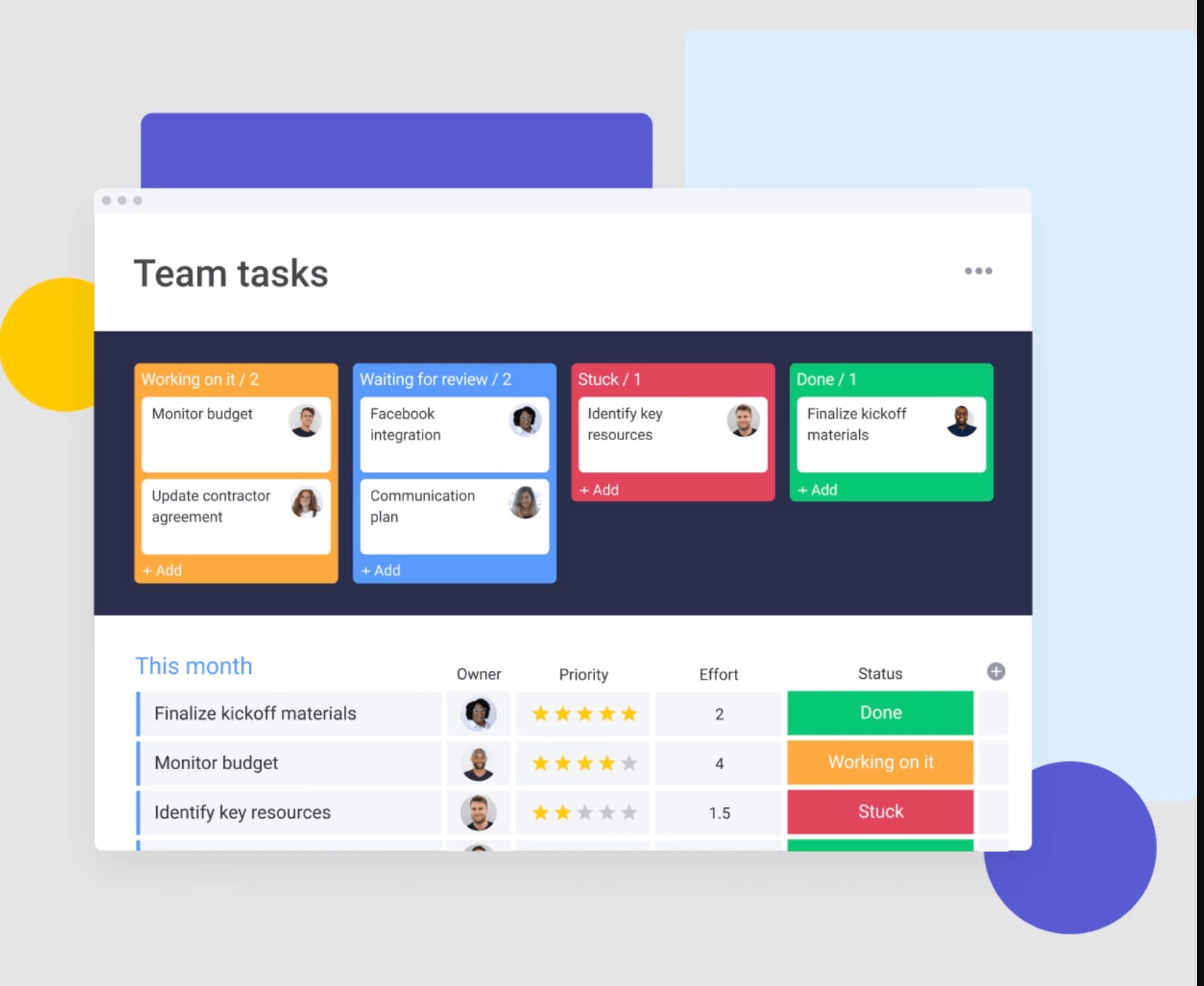
Essential platforms and techniques
Different project contexts call for different time management approaches. Selecting the right technique for your situation improves both efficiency and team adoption. Let’s explore the most powerful tools and methods that successful project managers use to keep their teams on track and deliverables on schedule.
Gantt charts for scheduling
Gantt charts excel at visualizing complex project timelines. They show task duration, dependencies, and resource allocation in an intuitive format that stakeholders quickly understand.
Use Gantt charts when projects have multiple phases, significant interdependencies, or when you need to communicate schedules to diverse audiences. They work particularly well for construction, event planning, and product launches.
The visual format reveals the critical path instantly, helping teams focus effort where delays would impact the end date.
Real-time dashboards for tracking
Executive dashboards transform raw project data into actionable insights. Instead of wading through detailed reports, leaders see key metrics at a glance.
Effective dashboards display:
- Schedule variance: How actual progress compares to plan
- Milestone status: Which key deliverables are complete, in progress, or at risk
- Resource utilization: Whether teams are over or under capacity
- Budget health: Current spend versus allocation
In monday work management, you can automatically populate dashboards from project data, ensuring metrics stay current without manual updates.
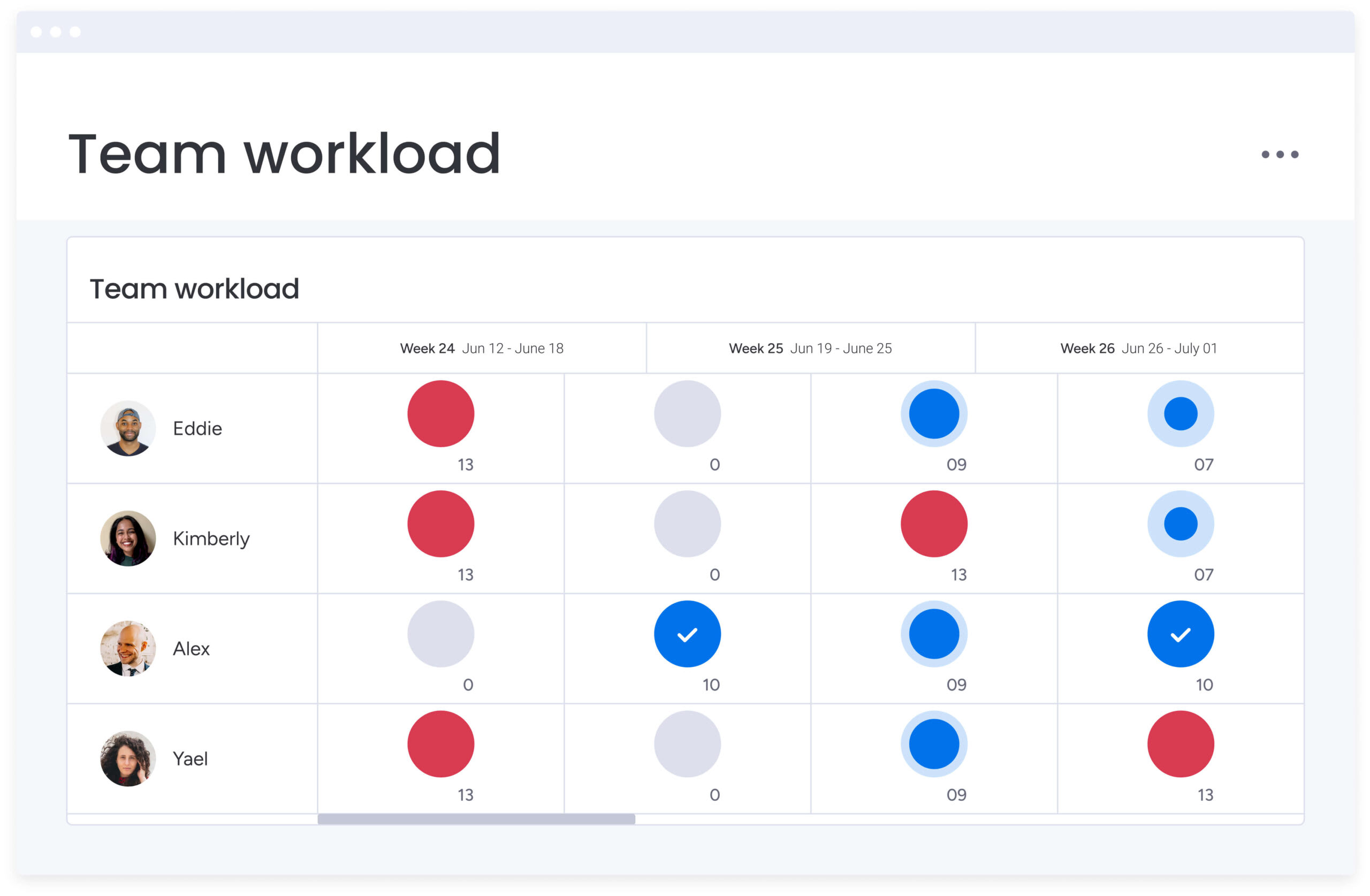
Timesheets for workload management
Time tracking provides the data foundation for accurate future estimates. When teams log actual hours against planned work, patterns emerge that improve planning precision.
This data reveals which activities consistently take longer than expected, which team members work most efficiently on certain tasks, and where process improvements could save time.
Workload views prevent the overallocation that leads to delays and burnout. Managers can see who’s overwhelmed and who has capacity, enabling proactive rebalancing.
Automation for AI-enhanced assignments
Intelligent automation eliminates manual time management overhead, a shift supported by the 80% of millennials who believe AI can help them do their jobs better, according to a monday.com report. AI analyzes project patterns to predict delays, suggest optimal task assignments, and flag risks before they materialize.
Some of monday work management’s AI capabilities include:
- Smart scheduling: AI suggests realistic timelines based on historical performance.
- Risk detection: Algorithms identify projects likely to miss deadlines.
- Resource matching: AI pairs tasks with team members based on skills and availability.
- Automated updates: Status changes trigger notifications and next steps.
These features help project managers focus on strategic decisions rather than administrative tasks.
How to unify time and project management across teams
When projects span departments, coordination complexity multiplies. Marketing waits on product specs. Operations needs IT infrastructure. Sales depends on marketing materials.
Without unified time management, these dependencies create bottlenecks that ripple across the organization. Teams optimize their own schedules while inadvertently blocking others.
Successful coordination requires several elements working together:
- Shared terminology: Everyone uses the same definitions for project phases, task types, and status indicators.
- Common standards: Estimation methods, reporting formats, and planning approaches align across teams.
- Centralized visibility: Dependencies between teams are mapped and monitored proactively.
- Clear protocols: Teams know how to request resources, escalate issues, and communicate changes.
How does your organization handle scheduling conflicts between departments? With shared workspace and communication platforms, monday work management makes cross-team coordination seamless.
Regular synchronization meetings help teams identify and resolve conflicts before they impact deliverables. These check-ins focus on dependencies, resource needs, and upcoming milestones rather than detailed status updates.
Take your next step with monday work management's advanced automation and AI
As project complexity grows, manual time management becomes unsustainable. By implementing intelligent tools that predict bottlenecks, optimize resource allocation, and handle routine administrative tasks, project managers can focus on strategic decisions that truly impact outcomes. Let’s explore how monday work management’s AI and automation can transform your approach.
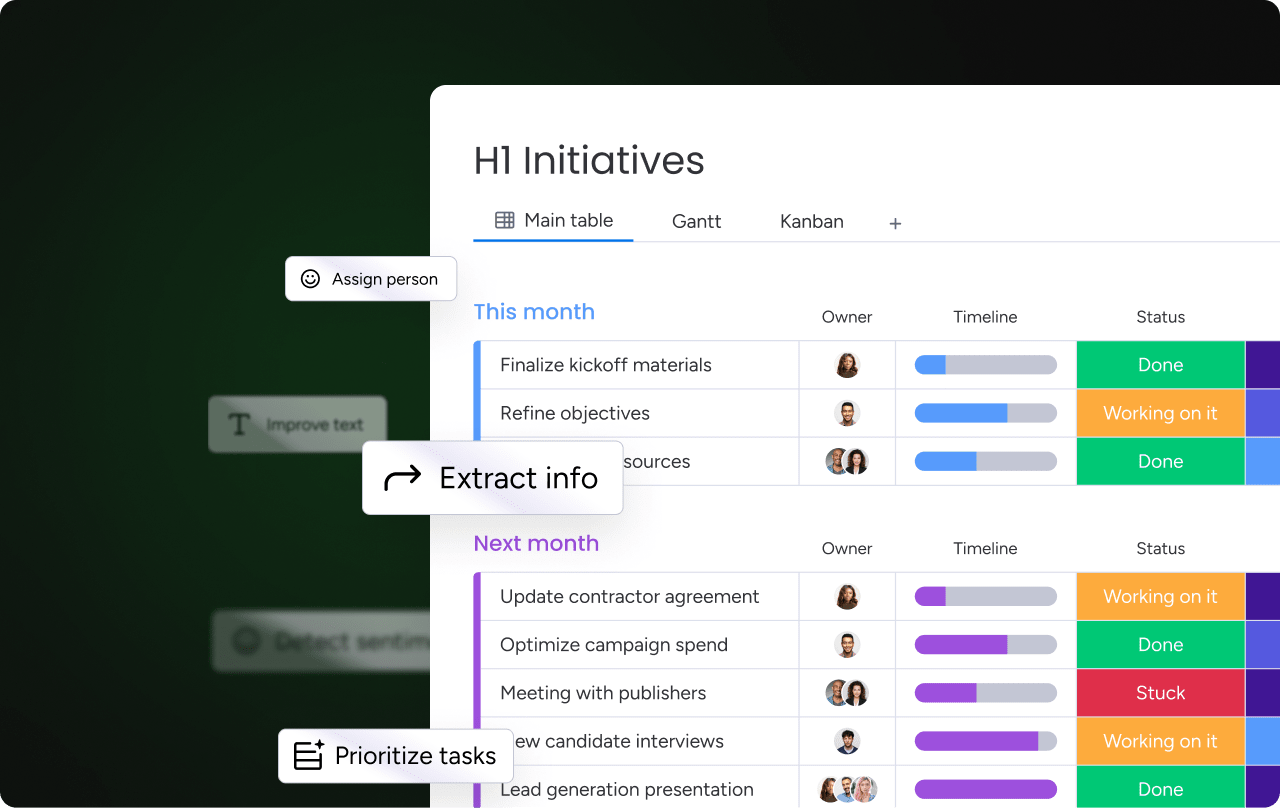
AI Blocks for routine tasks
AI transforms repetitive project management work. Instead of manually updating statuses, categorizing risks, or summarizing progress, monday work management’s AI Blocks streamline common activities:
- Status updates: AI analyzes task completion patterns and updates project health indicators.
- Risk categorization: Automatically classify and prioritize project risks by type and severity.
- Progress summaries: Generate stakeholder updates from project data instantly.
- Meeting insights: Extract action items and decisions from meeting notes.
This automation gives project managers more time for strategic work like building stakeholder relationships, problem-solving, and team development.
Digital workforce for proactive insights
AI-powered Digital Workers monitor projects continuously, surfacing insights humans might miss. They analyze patterns across multiple data points to identify emerging issues.
The Project Analyzer examines task completion rates, dependency chains, and resource allocation to predict delays before they occur. When patterns indicate risk, it alerts project managers with specific recommendations.
These proactive insights enable intervention while there’s still time to correct course, rather than discovering problems during status meetings.
Real-time resource allocation
AI optimization balances multiple factors when suggesting task assignments. It considers individual skills, current workload, project priorities, and historical performance simultaneously.
These insights are used by monday work management to match work with the most suitable team members, improving both project outcomes and job satisfaction by ensuring people work on tasks that match their capabilities.
Real-time rebalancing prevents overload situations while ensuring available capacity gets utilized effectively across all active projects.
Try monday work managementMove forward with faster results
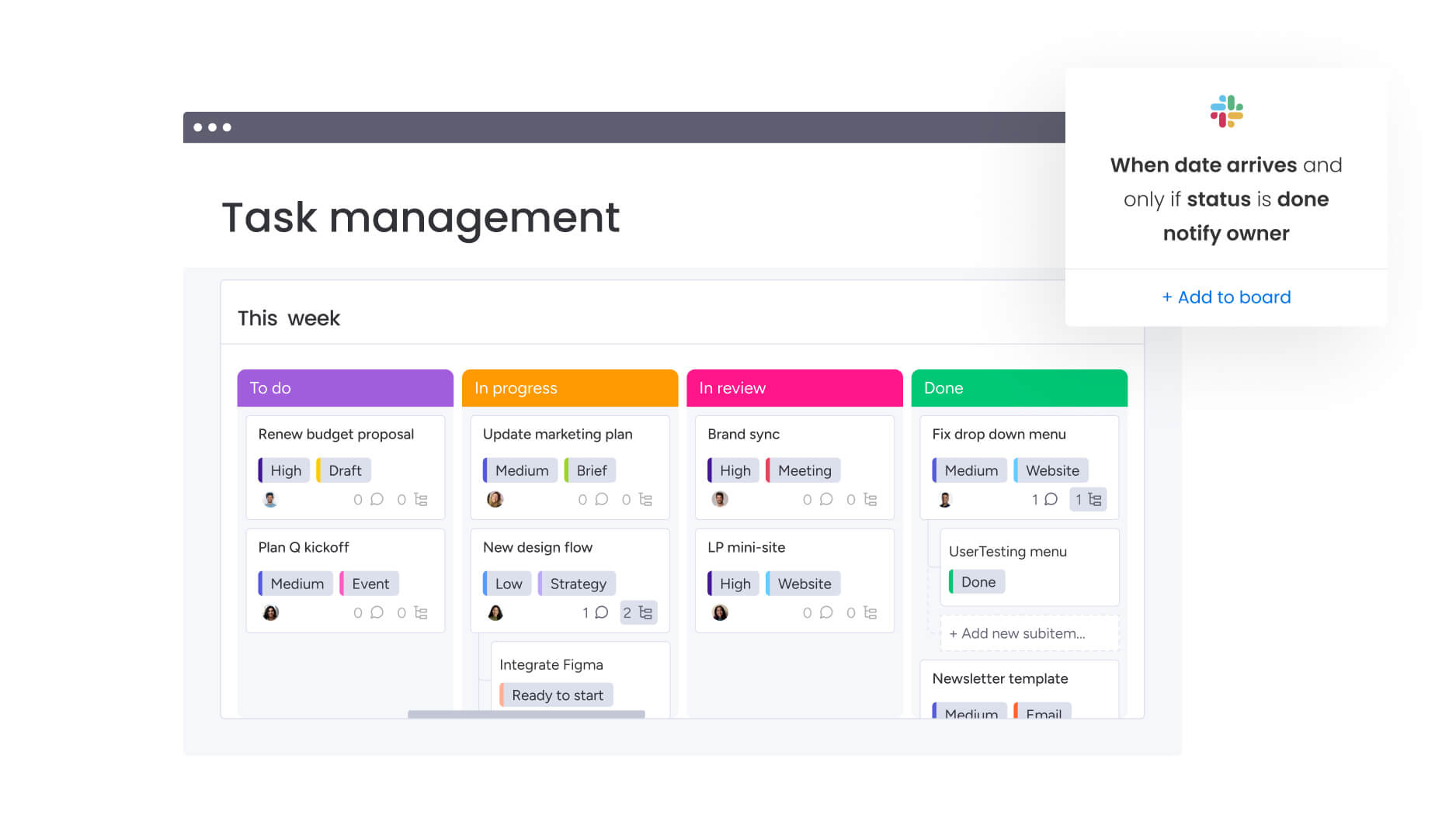
Project time management transforms from constant firefighting to predictable delivery when you apply structured approaches consistently. Start with clear objectives and detailed planning, then build in monitoring and adjustment capabilities.
The techniques outlined here provide a comprehensive framework, but success depends on adoption and continuous refinement. Focus on sustainable improvement rather than overnight transformation.
Ready to accelerate your project delivery? Get started with monday work management and gain the infrastructure to implement these practices at scale, with built-in intelligence that helps teams work smarter.
Try monday work managementFrequently asked questions
What is the difference between project time management and regular time management?
The difference between project time management and regular time management is that project time management focuses on coordinating multiple team members and resources toward specific deliverables with fixed deadlines, while regular time management typically involves individual productivity and personal scheduling.
How do you create a time management plan for complex projects?
Creating a time management plan for complex projects starts with breaking work into phases, estimating duration for each component, and building a schedule that accounts for dependencies and resource availability.
Can distributed teams effectively coordinate project time management?
Yes, distributed teams can effectively coordinate project time management by using centralized platforms that provide real-time visibility into progress, deadlines, and resource allocation across all locations.
Why is resource allocation crucial for project time management success?
Resource allocation is crucial because having the right people available at the right time prevents delays and ensures work can progress according to schedule without bottlenecks.
How should project managers handle unexpected changes to project timelines?
Project managers should handle unexpected timeline changes by assessing impact on critical path activities, communicating adjustments to stakeholders immediately, and reallocating resources to maintain key deliverables.
What role does communication play in effective project time management?
Communication ensures all team members understand their responsibilities, deadlines, and how their work connects to overall project success, preventing delays caused by misunderstandings or missing information.
